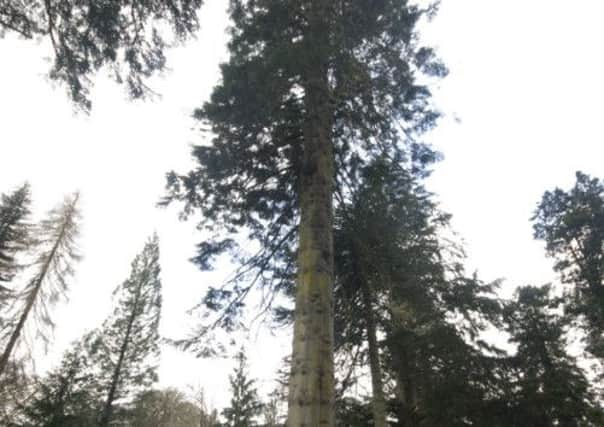Scotland’s trees are not just striking colours


However, as well as offering spectacular scenery, the country also boasts some of the tallest, largest and oldest trees in the UK, Europe and, in some cases, the world. And while many of these champion trees can be seen at any time of year, now is as good a time as any when the countryside is at its best.
With a Scottish Government public consultation on whether we should have a national tree closing on 3 December, it is also a last chance for people to offer their views on what species it should be and why.
Advertisement
Hide AdAdvertisement
Hide AdThe Tree Register of the British Isles (TROBI) has a database of more than 150,000 notable trees. Director David Alderman says among these Scotland has two contenders for Britain’s tallest with a Douglas fir at Reelig Glen Wood in Moniack, Invernesshire, measuring 64.8 metres in 2013, and a Grand Fir on the Ardkinglas Estate in Argyllshire measuring 64.3m in 2010 – both taller than Nelson’s Column in Trafalgar Square, London. The Moniack tree, planted in 1882, is part of a grove of tall Douglas firs which form the largest concentration of trees exceeding 55m in the British Isles. The Grand Fir at Ardkinglas Woodland Garden, on the banks of Loch Fyne, is thought to have been brought back from North America as a sapling and planted around 1875 by the Callander family.
Tree surgeon Iain Campbell Duncan, who helped measure the Ardkinglas tree for a charity event, says the Scottish climate plays a big role in helping these trees reach such great heights. “It’s the warm, damp climate that helps them grow as big as they are,” he says.
The fir is one of several champion trees on the estate, including what is described as “the mightiest conifer in Europe” – a European Silver fir with a girth of nearly 10m. However, the largest tree on the TROBI register is a Giant Sequoia at Cluny House, in Aberfeldy, which is more than 130 years old and had a girth of 11.3m when it was measured in 2009.
Cluny House Gardens were started in 1950 by Bobby and Betty Masterton, who specialised in Himalayan plants. Wendy Mattingley, who took over the garden from her parents in 1987, says there are actually two sequoias which are very similar in size. “This is a great tree-growing area,” she says. “It’s the soil and the climate. The trees were from the first introduction of this species in Scotland. In California, where they come from, they are inland and don’t have a huge amount of heat. It’s the temperate climate here they enjoy as well as the types of soil.”
Perthshire, dubbed Big Tree Country, is home to many other remarkable trees, including those planted at Blair Castle and the Atholl Estates by the Dukes of Atholl in the 18th and 19th centuries. Known as the “planting dukes”, they planted 27 million trees between 1738 and 1830, including exotic conifers and early introductions, of which at least 20 now top 46m. The tallest trees are two Grand Firs at 63.5m, but there is also a 59m Douglas fir.
Nearby at Birnam, an ancient oak tree is said to be the last survivor of Birnam Wood, which was immortalised in Shakespeare’s play Macbeth. Although not old enough to have been around during the playwright’s lifetime, the tree, whose trunk has a girth of 5.5m, is thought to be several hundred years old.
East towards Blairgowrie is the Meikleour Beech Hedge – listed in the Guinness Book of Records as the highest hedge in the world. In the opposite direction is Glen Lyon, home to Europe’s oldest tree – a yew at Fortingall Church. Its estimated age is anything from 2,000 to 5,000 years old and, according to legend, Pontius Pilate, the Roman governor of Judea who oversaw the crucifixion of Jesus, was born in the shade of the yew.
While the Scots pine is probably the tree that symbolises Scotland best – and is a favourite to become the country’s national tree – it is not known where the oldest specimen is.
Advertisement
Hide AdAdvertisement
Hide AdHowever the Forestry Commission’s book, Heritage Trees of Scotland, which highlights 130 of the country’s most remarkable trees, says one contender is the Glen Loyne “Granny” which is estimated to be around 550 years old. While this Invernesshire tree is inaccessible to the public, other old Scots pine can be seen in Ballochbuie Forest on the Queen’s Balmoral Estate in Upper Deeside, Aberdeenshire.
Some of the “wierd and wonderful” trees listed in the book are the Bicycle Tree at Brig O’ Turk in Stirlingshire, a century-old sycamore that has swallowed an anchor and a bicycle in the course of its long life, and the Twin Trees of Finzean in Aberdeenshire, two Scots pine trees joined together by a branch.
So whatever part of the country you live in, there are plenty of interesting trees and also a lot of choice when it comes to deciding Scotland’s national tree. Which one will you choose?
For more information about the Tree Register of the British Isles, visit: www.treeregister.org To read more about Scotland’s heritage trees visit: www.forestry.gov.uk/heritagetreesscotland
Information about the Ardkinglas Woodland Garden, Cluny House Gardens and Blair Castle can be found at: www.scotlandsgardens.org